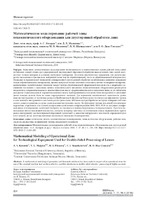| dc.contributor.author | Козерук, А. С. | ru |
| dc.contributor.author | Мальпика, Д. Л. | ru |
| dc.contributor.author | Филонова, М. И. | ru |
| dc.contributor.author | Шамкалович, В. И. | ru |
| dc.contributor.author | Диас Гонсалес, Р. О. | ru |
| dc.coverage.spatial | Минск | ru |
| dc.date.accessioned | 2018-06-01T17:14:32Z | |
| dc.date.available | 2018-06-01T17:14:32Z | |
| dc.date.issued | 2018 | |
| dc.identifier.citation | Математическое моделирование рабочей зоны технологического оборудования для двусторонней обработки линз = Mathematical Modeling of Operational Zone for Technological Equipment Used for Double-Sided Processing of Lenses / А. С. Козерук [и др.] // Наука и техника. – 2018. – №3. - С. 204-210. | ru |
| dc.identifier.uri | https://rep.bntu.by/handle/data/41726 | |
| dc.description.abstract | Выполнено математическое моделирование геометрических и кинематических связей рабочей зоны одной из типовых секций станка для одновременной двусторонней абразивной обработки высокоточных линз малой жесткости (с тонким центром) в условиях свободного притирания. Получено аналитическое выражение для расчета скорости скольжения в произвольно выбранной точке как на обрабатываемой, так и на обрабатывающей поверхностях. Поскольку в предлагаемой технологии одновременной двусторонней обработки колебательное движение совершают только обрабатывающие инструменты, причем выпуклый из них соединен с поводком жестко и совершает возвратно-вращательное (колебательное) движение вокруг центра обрабатываемой сферической поверхности, а шарнирное соединение последнего с выходным звеном исполнительного механизма технологического оборудования реализуется посредством сопряжения шарового наконечника поводка со сферическим гнездом в выходном звене, то во избежание раскрытия стыка (локального нарушения контакта между притирающимися поверхностями инструмента и заготовки) длина поводка должна быть не менее определенного значения. Для выявления аналитической зависимости длины поводка инструмента от величины радиуса обрабатываемой сферической поверхности линзы и коэффициента трения в зоне контакта инструмента и заготовки рассмотрена схема действия сил при обработке вогнутых поверхностей линз малого радиуса кривизны в случае расположения инструмента сверху. Коэффициент трения, входящий в полученное выражение, определяли для случаев шлифования суспензиями микропорошков М40, М28, М10 на чугунных шлифовальниках и полирования суспензией полирита на смоляном и пенополиуретановом полировальниках. При этом использовали метод «наклонной плоскости», согласно которому заготовку из оптического стекла первоначально притирали к инструменту соответствующей абразивной суспензией и, наклоняя инструмент с заготовкой, определяли угол в тот момент, когда заготовка начинала скользить по поверхности инструмента. | ru |
| dc.language.iso | ru | ru |
| dc.publisher | БНТУ | ru |
| dc.subject | Оптические детали | ru |
| dc.subject | Математическое моделирование | ru |
| dc.subject | Технологическое оборудование | ru |
| dc.subject | Рабочая зона | ru |
| dc.subject | Скорость скольжения | ru |
| dc.subject | Коэффициент трения | ru |
| dc.subject | Локальная погрешность | ru |
| dc.subject | Optical parts | en |
| dc.subject | Mathematical modeling | en |
| dc.subject | Technological equipment | en |
| dc.subject | Operational zone | en |
| dc.subject | Sliding velocity | en |
| dc.subject | Friction coefficient | en |
| dc.subject | Local error | en |
| dc.title | Математическое моделирование рабочей зоны технологического оборудования для двусторонней обработки линз | ru |
| dc.title.alternative | Mathematical Modeling of Operational Zone for Technological Equipment Used for Double-Sided Processing of Lenses | en |
| dc.type | Article | ru |
| dc.identifier.doi | 10.21122/2227-1031-2018-17-3-204-210 | |
| local.description.annotation | A mathematical modeling of geometric and kinematic relations has been made in respect of an operational zone for one of the standard machine tool sections which is used for simultaneous double-sided abrasive processing of highly-accurate lenses with a small rigidity (with a thin centre) under free lapping conditions. An analytical expression has been obtained for calculation of a sliding velocity in an arbitrarily selected point either on a surface to be processed or on a processing surface. As the proposed technology for simultaneous double-sided processing presupposes oscillatory motion of only processing tools then in order to eliminate a joint opening (a local contact fault between lapping surfaces of a tool and a work-piece) length of a drive piece must be not less than a specified value. In this case a convex tool is rigidly connected with a drive piece and it makes a reversing rotary motion (an oscillatory motion) around a centre of the processed spherical surface and a hinged joint of the centre with an output element of the technological equipment actuation mechanism is realized by transition of the drive piece ball end with a spherical seat in the output unit. In order to reveal analytical dependence of tool drive piece length on radius value of the processed spherical lens surface and friction coefficient in the contact zone of the tool and a work-piece the paper has considered a flow pattern of force while processing concave surfaces of lenses having small radius of curvature in case when the tool is positioned at the top. The friction coefficient included in the obtained expression has been determined for grinding while using suspensions of М40, М28, М10 micro-powders in a cast-iron grinding instrument and polishing while using polyrhythm suspension in a pitch and urethane-foam polisher. A method of the inclined plane has been used in this case and following the method a work-piece of optical glass has been initially lapped to the tool with the help of the appropriate abrasive suspension and the required angle has been determined at the moment when the work-piece started its sliding movement along the tool surface. | en |

